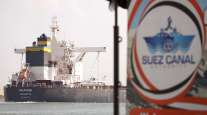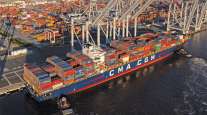Staff Reporter
Analysts: US Transport Better Prepared for Red Sea Disruptions

[Stay on top of transportation news: Get TTNews in your inbox.]
The U.S. transportation sector is in a better position to handle disruptions from the Red Sea with efforts to improve capacity amid a slowdown in freight, according to experts.
The Houthi movement in Yemen began targeting vessels transiting the Red Sea late last year as part of a larger response to the Israel-Hamas war. Project44 data shows that 445 vessels have been rerouted to avoid the region while only one is still waiting. It also found the majority of vessels are experiencing an increase in transit time ranging from seven to 20 days.
“Attacks by the Houthi rebels on commercial vessels in the Bab el-Mandeb Strait have persisted for over two months,” said Eric Fullerton, senior director of product marketing at Project44. “Currently, the vast majority of vessels are rerouting around the Cape of Good Hope rather than risking passage through the Red Sea.”

eia.gov
The Uber Freight Q1 2024 Market Update and Outlook Report on Feb. 7 found that ocean cargo travel has slowed by 40%. That amounts to nearly two weeks of delays across supply chains. The report also found that the majority of carriers will not resume operations in the region until the risk of attacks is eliminated.

Fullerton
“Depending upon where those vessels were in rotation and location, it may be a little soon to start gathering statistics of the impact of those delayed vessels, perhaps, bunching up on certain ports when they start arriving,” said Mollie LeBlanc, oceans expert at Uber Freight. “But overall, the port network in the United States is in a much better situation than it was during COVID.”
LeBlanc has seen some downstream effects on U.S. transportation such as increasing volumes being diverted through West Coast ports, but overall, she has yet to see significant disruptions.
LeBlanc anticipates an uptick in volumes once the delayed container vessels arrive but is confident the ports can handle it. She noted that ocean carriers developed a capacity surplus over the past year as vessels that were ordered back between 2019 and 2021 came online.

LeBlanc
“Overall, the shipper community should be supportive of the fact that there was this surplus capacity existing because it has allowed trade to adapt to a really bad situation," she said.
Project44 data also found that rates from China to the U.S. East Coast have increased by nearly 175% since October. It even discovered lanes that would not use the Red Sea and Suez Canal are spiking as well, as rates for Asia to the U.S. West Coast increased 97%. It warned of increasing fuel costs, too, with some ocean carriers announcing surcharges of $500 to $2,700.
“The impact to U.S. transportation is currently twofold: freight costs and container transit times,” Fullerton said. “First, freight costs are increasing across all lanes. The global container freight rate for a 40-foot container just recently hit record highs and has more than doubled since early December. While lanes from Asia to Europe have increased the most, rates for lanes to the U.S. are increasing as well.”

Joshi
Pawan Joshi, executive vice president of products and strategy at E2open, noted the increased transit times also mean higher costs for crews and fuel. But he also indicated it is a mixed bag when it comes to downstream effects given the current freight market.
“The good thing is, we were going through a weak phase in terms of demand capacity imbalances post-pandemic,” Joshi said. “So, there was excess capacity available; it’s not the 20 days didn’t take capacity offline. What it really did was it increased the transit time, which means the goods that were supposed to arrive today are going to arrive 20 days later.”
Joshi added that these shipments aren’t just finished goods but also raw materials, which could cause disruption downstream. He believes, though, the supply chain is better positioned to handle these disruptions because a slowdown in macroeconomic conditions has led to softer demand. He also says the recent Lunar New Year didn’t add much to the disruptions.
COMTO's April Rai offers tips to increase workforce diversity and grow profits.. Tune in above or by going to RoadSigns.ttnews.com.
“The rest of the world was preparing for the Lunar New Year over in Asia, which means a lot of the production was pre-done and a lot of the inventories were pre-deployed into certain regions, so we didn’t see that big of an impact,” Joshi said.
Project44 data instead found an increase in transpacific volumes as companies attempt to restock for Lunar New Year. Fullerton noted congestion is expected at East Coast ports due to rerouted lanes from Asia.
“Most years, Chinese manufacturers plan ahead to ensure sufficient inventory with this shutdown,” Fullerton said, “but with unplanned disruptions in the Red Sea, it will be difficult to hold inventory constant. China accounts for nearly 30% of global manufacturing.”
Want more news? Listen to today's daily briefing below or go here for more info:





